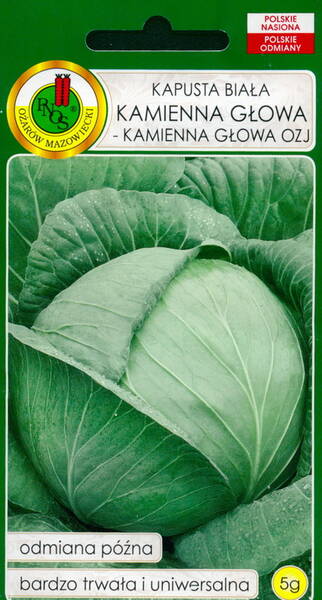Ex Tax: 1.85€
Ideal for long-term storage and very tasty when fermented!
A late-ripening variety that ripens 150-160 days after transplanting. Heads of cabbage are round, light green in color, weighing about 2.5-3.5 kg.
Seedlings are planted in open ground until May 30th. Excellent taste, high sugar and vitamin content.
It is good fresh and perfect for fermentation. Suitable too for fresh consumption and storage.
Heads of cabbage are fully formed by October. The shape of the head of cabbage is round, slightly flattened on top. Less typical, but also a flat-convex shape.
The average weight of one head of cabbage is 2-4 kg, and under ideal growing conditions it reaches 5-6 kg.
The rosette of leaves is not too wide - 65-80 cm in diameter (specimens with a rosette up to 100-110 cm are not uncommon).
The lower leaves are slightly raised. The upper leaves covering the head are light green. The head of cabbage is white in cross section. The stump is small, the veins on the leaves are thin.
The variety is characterized by a dense structure: there are practically no voids between the leaves, therefore even small-diameter heads of cabbage are quite heavy.
From the moment the seedlings are planted in the ground to the harvest, 110–125 days pass. If you are planting cabbage by seed, the growing season is 150–160 days.
Productivity of the variety: 8-10 kg / m2 (850-900 centners per hectare).
1,0 g = 250-300 seeds.
Advantages and disadvantages of the "Stone Head" white cabbage variety.
* Taste qualities. Cabbage can be eaten fresh, used for cooking first and second courses, harvested for the winter.
This versatility comes from its high sugar content.
* Dense structure of heads of cabbage.
* Resistant to cracking during maturation.
* Cold resistance.
* Drought resistance (the variety is specially adapted to hot, dry weather).
* Resistance to diseases (practically not susceptible to fusarium and is rarely affected by rot).
* Transportability (does not lose at all either in its marketable form or in consumer qualities during long-distance transportation).
* Long shelf life (if the storage conditions are observed, the taste will noticeably improve by the end of winter).
- As a disadvantage, sometimes harsh and not too juicy leaves are noted (but this is a distinctive feature of all late-ripening varieties of cabbage).
White Cabbage. Bot.: Brassica oleracea var. capitata L.
Did you know that... the size of the head of cabbage depends on the ripening period of cabbage (and on the variety), so a distance of 30-35 cm is left between plants of early-ripening varieties (between rows is 40-50 cm), for mid-season varieties - 50 cm (row spacing is 50-60 cm) and late varieties 60-70 cm with the same distance between rows. If cabbage is planted more often, the heads of cabbage will be smaller (smaller feeding area).
* Cabbage juice for gastritis.
It is best to use juice from crushed leaves of young white cabbage. You should drink it warm, half a glass 2-3 times 1 hour before meals for 2-3 weeks (it helps well with chronic gastritis, especially with low acidity of gastric juice).
Attention: cabbage juice can be stored in the refrigerator for no more than 2 days.












